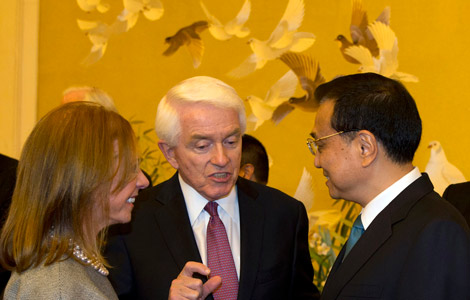China fuels Saskatchewan export boom
Updated: 2014-07-11 23:47
By PAUL WELITZKIN in New York (China Daily Canada)
|
||||||||
As China's middle class expands, so will its demand for products and services that accompany a middle-class lifestyle. And waiting in the wings to meet those needs is Saskatchewan, the Canadian province that has a Chinese community of more than 10,000.
"Saskatchewan is perfectly positioned to capture a big part of this growth," said Yi Zeng, director of trade and development in Asia for the Saskatchewan Trade & Export Partnership (STEP).
STEP concluded a trade mission to China on June 29, and Chiung-hui Joanne Huang, a trade specialist for the group STEP, said the trip didn't result in a big new contract or agreement.
"We prefer to use these trips to lay the groundwork for agreements in the future," she said. "We focus instead on setting up personal meetings so companies (in Saskatchewan) can meet and talk directly to importers who require their products or services."
The province's economy is built on agriculture, mining and energy and those sectors are also the pillars of its exports. Trade with Asia is growing, particularly to China. In 2004, Saskatchewan exports to China totaled about C$772.23 million ($723.29 million). In 2013, exports were about C$2.66 billion, according to STEP.
Agriculture is a huge part of Saskatchewan's trade with China and it was the focus of Huang's group on the trade mission. Peas and canola oil are among the most popular Saskatchewan products sold to China. The province provides nearly 85 percent of China's pea imports; most are used to make noodles.
Huang sees another market as a huge opportunity for Saskatchewan. "We have an excellent chance of being able to penetrate the retail and health food market in China," she said. "Customers in China's major cities realize that what they eat will affect their health."
A good example Huang said is the growing yogurt market in China. "There is no reason Chinese consumers can't sprinkle some flaxseed or oatmeal (from Saskatchewan) on their yogurt. This is a new trend that we think will emerge in the next five to 10 years."
Saskatchewan, home to 1.1 million people, may not be the first Canadian province that comes to mind when thinking of an export juggernaut. Sometimes overshadowed by its neighbor to the west, Alberta, Saskatchewan is now the country's fourth-biggest exporter, bigger than the more populous British Columbia. Most of the Chinese residents live in Regina and Saskatoon, the two largest cities.
STEP has a unique history. Until 1996, it was a part of the provincial government. Then the organization was turned into a public-private partnership. While the province provides 70 to 80 percent of its yearly budget of C$3 million, about 450 companies based in Saskatchewan provide the rest through membership fees.
Eligible companies must have a product, service or technology that they sell outside of the province. STEP employs about 30.
Mining is another major component of the province's economy. Saskatchewan has more than 50 percent of the world's potash reserves. Potash refers to potassium-bearing minerals used in fertilizers.
paulwelitzkin@chinadailyusa.com

 Brazil launches China desk to handle economic ties with China
Brazil launches China desk to handle economic ties with China
 NY Wheel reels in Chinese EB-5 investors
NY Wheel reels in Chinese EB-5 investors
 The Penguins of Madagascar to enter China
The Penguins of Madagascar to enter China
 Film ambassador promotes Chinese films, TV series in US
Film ambassador promotes Chinese films, TV series in US
 Panda cub Bao Bao turns one
Panda cub Bao Bao turns one
 HK kid's symphony returns to NY
HK kid's symphony returns to NY
 China, US reach agreement
China, US reach agreement
 40 bodies from jet returned to Dutch soil
40 bodies from jet returned to Dutch soil
Most Viewed
Editor's Picks

|

|

|

|

|

|
Today's Top News
US to issue antidumping decision on Chinese solar products
Manufacturing hits an 18-month high
Transformers producers hit with breach of contract suit
US chipmaker to be deemed monopoly
Chinese still seek Beckel termination
One dead in shooting in Philadelphia
France: Air Algerie plane 'probably' crashed
TransAsia crash while landing in Taiwan
US Weekly

|

|







